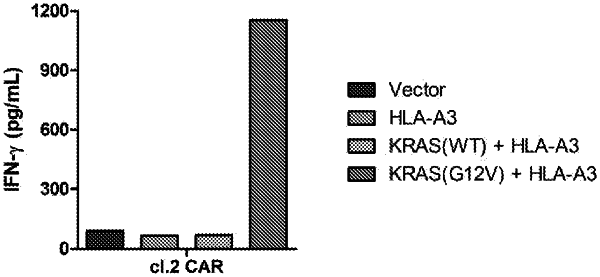| CPC C07K 16/2833 (2013.01) [A61K 35/17 (2013.01); C07K 14/7051 (2013.01); C07K 14/70514 (2013.01); C07K 14/70517 (2013.01); C07K 14/70521 (2013.01); C07K 16/2809 (2013.01); A61K 38/00 (2013.01); C07K 2317/24 (2013.01); C07K 2317/31 (2013.01); C07K 2317/33 (2013.01); C07K 2317/622 (2013.01); C07K 2319/03 (2013.01)] | 15 Claims |

|
1. A molecule comprising an antigen-binding domain that can bind to a peptide-human leukocyte antigen (HLA)-beta-2 microglobulin complex, wherein said antigen-binding domain is selected from the group consisting of:
(i) an antigen-binding domain comprising a complementarity determining region (CDR)-VL1 comprising the amino acid sequence QDVNTA (SEQ ID NO:33); a CDR-VL2 comprising the amino acid sequence SAS; a CDR-VL3 comprising the amino acid sequence QQSGYAPIT (SEQ ID NO:82), a CDR-VH1 comprising the amino acid sequence GFNISYYS (SEQ ID NO:89), a CDR-VH2 comprising the amino acid sequence VDPDSDYT (SEQ ID NO:96); and a CDR-VH3 comprising the amino acid sequence SRSWIHMFSMDY (SEQ ID NO:103);
(ii) an antigen-binding domain comprising comprises a CDR-VL1 comprising the amino acid sequence QDVNTA (SEQ ID NO:33); a CDR-VL2 comprising the amino acid sequence SAS; a CDR-VL3 comprising the amino acid sequence QQSLYGPFT (SEQ ID NO:84); a CDR-VH1 comprising the amino acid sequence GFNIAYEY (SEQ ID NO:91); a CDR-VH2 comprising the amino acid sequence IGPDSGYT (SEQ ID NO:98); and a CDR-VH3 comprising the amino acid sequence SRVWYYSTYGMDY (SEQ ID NO:105);
(iii) an antigen-binding domain comprising a CDR-VL1 comprising the amino acid sequence QDVNTA (SEQ ID NO:33); a CDR-VL2 comprising the amino acid sequence SAS; a CDR-VL3 comprising the amino acid sequence QQYLYQPWT (SEQ ID NO:87); a CDR-VH1 comprising the amino acid sequence GFNIDYYG (SEQ ID NO:94); a CDR-VH2 comprising the amino acid sequence LYGGSDST (SEQ ID NO:101); and a CDR-VH3 comprising the amino acid sequence SRQYSAYFDY (SEQ ID NO:108); and
(iv) an antigen-binding domain comprising a CDR-VL1 comprising the amino acid sequence QDVNTA (SEQ ID NO:33); a CDR-VL2 comprising the amino acid sequence SAS; a CDR-VL3 comprising the amino acid sequence QQGLYYPWT (SEQ ID NO: 88); a CDR-VH1 comprising the amino acid sequence GFNVSYSS (SEQ ID NO: 95); a CDR-VH2 comprising the amino acid sequence IWPDSGQT (SEQ ID NO: 102); and a CDR-VH3 comprising the amino acid sequence SRSSYFDAMDY (SEQ ID NO: 109);
wherein said peptide comprises a modified peptide derived from a p53 polypeptide, wherein said modified peptide comprises the amino acid sequence SEQ ID NO:15, wherein said HLA is a class I HLA, and wherein said antigen-binding domain does not bind to a complex that includes a wild-type version of the modified peptide.
|